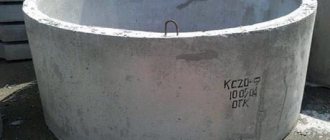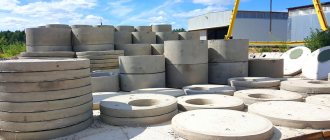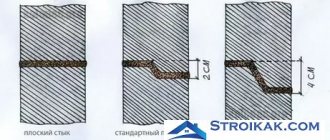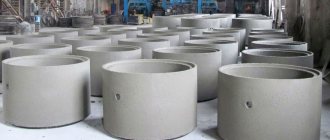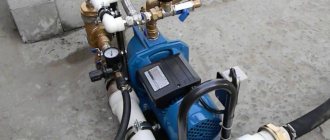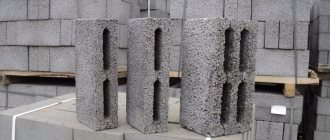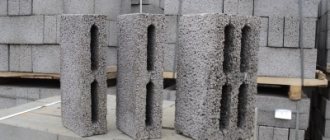Well rings, made of concrete or polymer materials, are used when constructing a reservoir for collecting drinking water. The design must protect the liquid from external factors and not be destroyed by temperature changes. The material used must comply with sanitary and hygienic standards and not emit carcinogenic substances.
Where are they used?
The scope of application of reinforced concrete rings depends on the materials from which they are made. For their production, different grades of concrete, crushed stone and sand with a wide granulometric composition, metal reinforcement or mesh are used. They provide a sufficient margin of safety for the use of concrete rings in the construction of wells for drinking water, wells, collectors, septic tanks, inspection tanks, sewers, and gas pipelines. Drainage systems are also mounted on reinforced concrete rings.
Return to contents
Scope of application
The concrete ring is used in the construction of buildings and structures for various purposes to organize communications. Wells are collected from them:
- Sewage cesspools and septic tanks;
- Construction of wells for drinking wells;
- Storage wells for drainage (storm drainage);
- Telephone shafts containing optical and copper communication equipment;
- Inspection shafts on sewer networks for any purpose.
You can also find unusual uses of sewer rings: flower beds, rooms for overnight stays - an invention that deserves special attention.
Marking, size range
Concrete products are designated according to the area of application and dimensions. Units of measurement are decimeter or meter. Examples of letter markings according to GOST:
- KS - wall concrete rings for equipment of inspection or necks;
- KSD - wall products with a bottom;
- KO - with support;
- KFK - for septic tanks and fecal systems;
- KLK - storm drains;
- KLV - wells-water intakes in storm drains;
- KVG - for the construction of water and gas pipelines.
Table of markings and sizes of rings.
The numbers contain information about the internal cross-section and height of the reinforced concrete ring. Example: KS 6-10 is a concrete wall-type structure with an internal section of 6 dm, a height of 10 dm or 1 m. Standard dimensions of concrete rings: cross-section - 7-20 dm, height - 1-20 dm, wall thickness - 0.7-2 dm.
Marking may include the grade of concrete used, usually from M200 to M500, and information about reinforcement. For example, standard wall rings for wells are not reinforced, since the concrete itself can withstand lateral loads and work in compression. Reinforcement is necessary for rings for use in difficult soil conditions. To do this, take steel rods up to 1 cm thick or reinforcing mesh measuring 0.6-1 mm.
The weight of concrete rings varies in the range of 44–1470 kg.
Return to contents
What is it suitable for?
Thanks to their excellent technical characteristics, sand-polymer prefabricated rings have found a wide range of uses:
- For the construction of a caisson.
- Construction of tanks for technical water.
- Sewage collection facilities.
- When installing a drainage system.
- Lookout.
Let's look at the features of some of them.
Observation
An ideal solution if underground communications are being laid. It is especially effective if there are connection points along the route or a long sewer pipe is laid. An inspection well made of polymer products will allow you to service the water supply or clean the sewerage system.
Rotary
If the highway has a 45-degree turn or branches, then a collector is also constructed from this material. Additionally, he serves as a lookout.
Variable
If along the route it is necessary to combine pipes of different heights into one sewerage or water supply system. It can also be used when it is necessary to bypass underground structures. If the natural landscape has a large slope, then a drop well will reduce the speed of wastewater. The difference can be arranged to a height of 300 to 600 mm.
What qualities do they meet?
GOST 8020-90 defines the properties characteristic of reinforced concrete rings. The markings, scope of application, and dimensions of standard structures are described here. The strength values of concrete types used for pouring rings are standardized in GOST 10180. GOST 10060 includes information on the frost resistance of the material, and GOST 12730 - on water resistance. Compliance with GOST requirements provides the following advantages of rings:
- availability of installation at different depths in soil of any quality;
- lightness and high rates of masonry;
- ease of installation of waterproofing and insulation;
- reliability;
- ability to withstand any mechanical, aggressive influences;
- ease of repair and operation;
- durability.
The only drawback is the weight. For this reason, there is a need to use lifting equipment to construct concrete rings.
Return to contents
Installation of concrete rings
For vertical installation of concrete rings in the ground, machine and manual methods are used; existing special equipment allows you to make round holes in the ground for any standard outer diameter of the well - for this, special drills or attachments in the form of horizontal knives are used. Homeowners who cannot afford to order special equipment often turn to the services of private craftsmen (shabashniks) who install concrete sewer wells manually.
When carrying out the work, two technologies are used: in the first case, they dig a deep hole and lower the rings into it, using a winch or holding them with their hands using ropes tied to mounting hooks. The second method consists of installing the ring on its workplace and digging out the earth from the inside, while as it deepens, the product falls down under its own weight.
Kinds
There is a classification of concrete rings according to GOST and the type of structural design of standard sizes (diameter - 7-12 dm, height - 0.1-1 meter).
Return to contents
Auxiliary
Concrete rings are made to order, for example, when non-standard sizes, shapes or additional holes are needed. Additional and supporting concrete rings are used during the installation of complex technological objects, for arranging turns of utility lines, during the construction of a well neck, when drainage systems are installed. Such rings can be standard or square.
Return to contents
Wall
The rings are characterized by the absence of additional fasteners. They are most often used to construct necks. They are easy to install: the products are stacked on top of each other, and the seams are sealed with concrete mortar. Disadvantages - instability of the structure, the possibility of destruction at the slightest shift of soil.
Return to contents
With a lock
Designs with a lock are popular because of their reliability. The main task of the lock is to ensure the tightness of joints and increase stability. A concrete product with a recess in the end is able to withstand powerful quicksand.
Return to contents
Precast concrete rings
The production of prefabricated reinforced concrete rings is carried out at the factory. They feature improved technical characteristics. Because of this, they are endowed with many advantages.
- Frost resistance provided by the strong bond between steel and concrete after drying.
- Anti-corrosion resistance obtained due to the protection of reinforcement with concrete.
- Fire resistance.
- Durability in any operating conditions. Strengthening with reinforcement makes it resistant to heavy loads. Thanks to the use of high-grade concrete, the structure does not lose its characteristics, does not deform or collapse over time.
- Low cost of products.
There is only one drawback - a lot of weight.
Return to contents
With bottom
Ring with bottom.
Reinforced concrete rings with a finished sealed and waterproof bottom are used to equip sewer wells, settling chambers, and septic tanks. The bottom protects the reinforced concrete structure from leakage of groundwater and from the seepage of harmful substances into the soil. The most common dimensions in cross section (meter), height (dm), weight (kg):
- 1 x 9 x 830 kg;
- 1.5 x 9 x 1400 kg;
- 2 x 9 x 2300 kg.
Return to contents
With floor slab
Products with floor slabs are designed for constructing deep wells. Such a reinforced concrete ring is the final element of the structure and has a hole in the reinforced concrete floor slab, offset from the center for installing the neck of the well. Reinforcement with a floor slab gives the ring greater strength and reliability.
Return to contents
Polymer rings for sewerage
Another type of large-diameter rings is sold on the construction market, from which sewer wells can be assembled; they are made from a composite consisting of polymer and sand. Polymer sand rings, unlike concrete ones, have the following features:
- The weight of one element with a diameter of 1 m is about 45 kg, so they are easy to load, transport and assemble.
- Polymer sand products are resistant to corrosion and most aggressive chemicals; the sewage system made from them does not require waterproofing.
- Resistant to high and low temperatures over a wide range and their differences.
- Installation of sewer rings on a tongue-and-groove locking connection prevents displacement of elements and ensures high sealing.
- Their service life, unlike concrete analogues, according to manufacturers reaches 100 years.
- The main disadvantage of the products is their prohibitively high price, which limits their scope of application.
- Also, due to the low weight, when constructing wells from dug-in polymer-sand segments, it is better to bury them with a cement-sand mixture - when it hardens, it will create a rigid, heavy frame, although it will further increase the cost of the entire structure.
Rice. 10 Dimensions and design of well plastic rings for sewerage installations
Related article:
Sewage tanks - types and materials of manufacture, installation diagrams . It may be interesting to read about ready-made containers that are used to construct storage tanks when constructing an autonomous sewer system.
Types and sizes of polymer rings
The most common internal diameters of the wall polymer-sand sewer element are 750, 1000 and 1500 mm, its standard height is 200 mm; higher rings of 250 mm are less common. Prefabricated wells are equipped with a bottom up to 50 mm thick and cone-shaped top plates with a height of 80 to 150 mm, which have a central round hatch closed with a polymer lid.
It might be interesting to know about the water supply and sewerage protection zone
Installation of sewer wells made of polymer materials
Due to its low weight, installation of a drainage polymer-sand well takes a small amount of time; the main labor costs go to digging the hole. When installing a septic tank, the assembly of an additional drainage well is carried out in the following order:
- Dig a hole of the required depth mechanized or manually, controlling the verticality of the walls with a plumb line with a load.
- Before installing the rings, sand and crushed stone with a total thickness of about 700 mm are poured into the bottom of the pit, then installation begins.
- One person lowers into the shaft, and the second gives him rings on a rope, the weight of which does not exceed 45 kg. After complete lock assembly of the entire structure, a cone-shaped plate with a hatch for installing the cover is installed on top; a hole for the drain pipe can be cut from the outside or inside of the well with a grinder with a metal or concrete disc.
- At the end of the work, the free space between the pit and the polymer-sand rings is filled with a cement-sand mixture in a ratio of 1:4 or 1:5 (depending on the brand of cement).
Rice. 11 Price list 2022 for polymer sand modules
To install a drainage sewer well with your own hands, most homeowners use concrete rings of different sizes, covering the entire structure with a slab with a hatch and a polymer cover. An alternative to concrete products is the installation of rings made of polymer sandstone, however, due to their high cost and low weight, which weakens the locking joints, the product is not in wide demand among the average consumer and is rarely used for constructing drainage sewer wells.
Production technology
Making reinforced concrete rings is a labor-intensive process that requires certain skills and knowledge. Therefore, for the construction of a small well, it is more advisable to purchase ready-made concrete products. You should know that the formwork for the rings is quite complex in its structural design. Casting work requires precision and accuracy. Compliance with the rules will avoid unevenness, loss of strength and the formation of voids in concrete. The main stages of ring production are described below.
Return to contents
Preparation of materials and tools
Required materials for formwork: two barrels and window awnings.
For formwork you will need:
- two steel barrels of different sizes;
- door or window awnings;
- fastening fittings;
- “pencil” for metal;
- grinder, cutting disc.
To prepare the solution:
- ready-made dry mortar or individual ingredients for mortar;
- concrete mixer;
- a bucket with which to measure the required volume;
- vibration compactor.
Return to contents
Basic requirements for the production process
- It is necessary to ensure sufficient strength of the collapsible form for the concrete rings.
- High-grade mixture not lower than M500.
- Fine aggregate - crushed stone with a grain size of 0.5-1 cm, washed sand.
- High-quality vibration compaction.
- Heating during operation at temperatures up to 5 0C.
Return to contents
Construction of formwork and frame
The outside of a cylindrical barrel is marked with two longitudinal “pencil” lines across the metal in half. Two door or window awnings are attached to the marked lines. Their bends must coincide with the drawn line. The same marking is applied from the inside of the cylinder, along which an incision is made with a grinder. This allows you to make the formwork drop-down. Fastening fittings are used to connect the halves.
The second cylindrical barrel should be smaller than the first. The same marks are made on it as on the first one with a distance between the lines of 1/3 from each other along the circumference. Canopies and spindles are also attached. The cylinder is cut along one line. The hinged parts must be assembled so that the inside of the structure is 5-10 cm higher than the external formwork.
The cylinders should open: the top one - outward, the inner one - inward. A reinforcing frame made of steel reinforcement or metal mesh is poured with concrete in the support ring, forming a strong reinforced concrete layer.
Return to contents
Filling with composition
To prepare the pour, you can use a ready-made concrete mixture or make it yourself. In the latter case, it is customary to take the ratio of cement to crushed stone and sand equal to 1: 1: 3. The volume of water is determined visually so that the solution is evenly distributed inside. The liquid is added in parts with thorough mixing.
The finished concrete solution is poured in portions. Each layer is carefully compacted. To do this, it is better to use a special vibration device. The large weight requires installation by a crane, so four mounting loops with a cross-section of 8-10 mm are installed in the reinforced concrete rings at the molding stage. The ends of the wire are bent and buried in concrete at a distance of 40-50 cm.
Return to contents
Seal
The entire volume is qualitatively compacted to remove air, which increases the strength of the finished product. Bayoneting or tamping with a rod partially solves the problem. In the absence of a vibrating platform, the use of a conventional hammer drill is allowed. To do this, instead of a peak, a reinforcement with a metal plate welded to its end is clamped.
Return to contents
Dismantling
The bolts of the external formwork are loosened. To make the mold easier to separate, the walls are tapped with a hammer. The inner part will be easier to remove if you first place two square pipes in it. After the concrete has thickened and hardened, these parts are simply knocked out of the concrete mold.
Return to contents
Advantages and disadvantages
Reinforced concrete structures have long occupied a leading position in the building materials market, but even when using them, the buyer must be prepared to encounter some difficulties. When compared with similar products made from other materials (plastic, polymer mixtures), undeniable advantages can be identified:
- suitability for all types of structures;
- affordability of prices;
- large selection of size models;
- durability and strength ensured by the use of heavy reinforced concrete grades 200-500;
- rigidity of the structure, which can also be installed on unstable soils;
- simplicity and speed of installation;
- the ability to produce components on site with your own hands;
- reliable protection against seasonal swelling of the soil and against entry into the groundwater system.
Reinforced concrete structures.
Disadvantages include:
- transportation difficulties;
- dimensions and weight, which require the use of special equipment during installation;
- lack of mobility (it is extremely difficult to move an installed well).
However, these difficulties do not affect the popularity of concrete rings in any way. Buyers are well aware of both transport and installation costs and are prepared for them in advance.
Price
The price tag for polymer products will differ depending on the features and technology of creation, as well as the manufacturer itself. The final cost is affected by diameter, height, wall thickness, etc. Plus, each element of a prefabricated well will have an individual cost. Approximate prices are shown in the table below:
| View | Characteristics | Price thousand rubles |
| Ready well “Yenisei” Height 2 meters | Thickness 50 mm and outer diameter 110 cm | 14,5 |
| Ready well “Yenisei” Height 3 meters | Thickness 50 mm and diameter 110 cm | 21.3 |
| Polymer ring | Height 20 cm and diameter 100 cm | 1700 |
| Ring with cap | Diameter 80, height 30, neck diameter 75 cm | 29 |
Important! There may be a different manufacturer in your area, and therefore the price will be different. Therefore, it is better to compare several manufacturers before purchasing.

